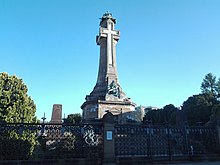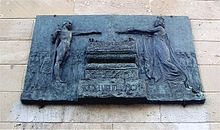| Revision as of 18:06, 27 October 2024 editMoonraker12 (talk | contribs)Extended confirmed users13,065 edits Intro/ add linkTag: Disambiguation links added← Previous edit | Latest revision as of 14:03, 30 October 2024 edit undoR'n'B (talk | contribs)Administrators421,336 editsm Disambiguating links to Votive church (link changed to Atonement in Christianity) using DisamAssist. | ||
| Line 73: | Line 73: | ||
| | materials = | | materials = | ||
| }} | }} | ||
| The '''Expiatory Chapel''' in ] is a monument-chapel ] and commemorate the site at which the king ] was murdered on July 29, 1900, by the anarchist ]. It stands near the entrance to the ] on Viale Regina Margherita and Via Matteo da Campione. Umberto's son ] commissioned the aged architect ], and the work was completed by his pupil ] in 1910. Obelisk-like crosses emerge from a stone chapel, and are surmounted by bronze crown and royal symbols of the ]. The entrance is surmounted by a Pietà by the sculptor ]. | The '''Expiatory Chapel''' in ] is a monument-chapel ] and commemorate the site at which the king ] was murdered on July 29, 1900, by the anarchist ]. It stands near the entrance to the ] on Viale Regina Margherita and Via Matteo da Campione. Umberto's son ] commissioned the aged architect ], and the work was completed by his pupil ] in 1910. Obelisk-like crosses emerge from a stone chapel, and are surmounted by bronze crown and royal symbols of the ]. The entrance is surmounted by a Pietà by the sculptor ]. | ||
| There is another such expiatory chapel to atone for a regicide, the ] in Paris, built to atone for the execution of ]. | There is another such expiatory chapel to atone for a regicide, the ] in Paris, built to atone for the execution of ]. | ||
Latest revision as of 14:03, 30 October 2024
Monument and chapel in Lombardy, Italy| This article includes a list of references, related reading, or external links, but its sources remain unclear because it lacks inline citations. Please help improve this article by introducing more precise citations. (March 2019) (Learn how and when to remove this message) |
| Expiatory Chapel | |
|---|---|
| Cappella Espiatoria | |
 | |
| Location | 7/a via Matteo da Campione, Monza |
| Country | Italy |
| Denomination | Roman Catholic |
| Website | Website of the Ministry of Culture |
| History | |
| Status | Memorial Chapel |
| Founder(s) | Victor Emmanuel III, Queen Margherita |
| Architecture | |
| Functional status | Museum |
| Architectural type | church |
| Completed | 1910 |
The Expiatory Chapel in Monza is a monument-chapel built to atone and commemorate the site at which the king Umberto I of Italy was murdered on July 29, 1900, by the anarchist Gaetano Bresci. It stands near the entrance to the Royal Villa of Monza on Viale Regina Margherita and Via Matteo da Campione. Umberto's son Vittorio Emanuele III commissioned the aged architect Giuseppe Sacconi, and the work was completed by his pupil Guido Cirilli in 1910. Obelisk-like crosses emerge from a stone chapel, and are surmounted by bronze crown and royal symbols of the House of Savoy. The entrance is surmounted by a Pietà by the sculptor Lodovico Pogliaghi.
There is another such expiatory chapel to atone for a regicide, the Chapelle expiatoire in Paris, built to atone for the execution of Louis XVI.


Sources
- Information from Italian Misplaced Pages entry
- Italy including Leghorn, Florence, Ravenna and routes through France, Switzerland, and Austria: handbook for travellers by Karl Baedeker, page 194.
45°35′28″N 9°16′08″E / 45.59111°N 9.26889°E / 45.59111; 9.26889
This article about a Roman Catholic church building in Italy is a stub. You can help Misplaced Pages by expanding it. |